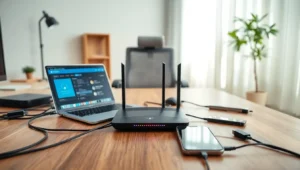In a world where connectivity reigns supreme, networking LED indicators are the unsung heroes of our digital lives. These little lights may seem trivial, but they pack a punch when it comes to troubleshooting and ensuring smooth communication. Ever wondered why your Wi-Fi is slower than a snail on a treadmill? Those blinking lights hold the answers, guiding users through the maze of connectivity like a traffic cop in a chaotic intersection.
But let’s be real: understanding these indicators doesn’t have to be as dull as watching paint dry. With a sprinkle of humor and a dash of insight, diving into the world of networking LED indicators can actually be enlightening. So buckle up and prepare to decode the colorful symphony of lights that keep our online experiences bright and connected.
Table of Contents
ToggleOverview of Networking LED Indicators
Networking LED indicators play a crucial role in understanding network status and performance. They provide instant feedback about connectivity, helping users manage their network environments effectively.
Importance in Modern Technology
Networking LED indicators serve as vital tools in technology today. They simplify the troubleshooting process when connectivity issues arise. A simple glance at an LED can inform users whether devices are online, malfunctioning, or completely powered off. Data from various sources indicates that efficient network management hinges on these visual cues. An active light often signals a stable connection, while a blinking light may denote data transmission. Clear acknowledgment of these signals enhances user experience and network reliability.
Key Features to Consider
Several key features define effective networking LED indicators. Color coding commonly indicates specific statuses, such as green for active connections and red for errors. Users should also consider the position of these indicators; visibility enhances usability and quick assessment. The response time of LEDs matters as well; indicators that flash promptly during activity provide more accurate feedback. Durability aspects are essential too, especially for equipment in demanding environments. Brightness levels can affect readability in various lighting conditions; thus, choosing indicators that balance visibility and energy efficiency remains important.
Types of Networking LED Indicators
Networking LED indicators come in various types, each serving a distinct purpose. Understanding these types enhances effective network management.
Status Indicators
Status indicators show the operational state of devices. They usually offer basic information about connectivity and power. Common colors include green, which indicates a good connection, and amber or red, suggesting issues. Some devices blink to represent specific actions like data transmission. These quick visuals save time by allowing users to assess network status at a glance.
Diagnostic Indicators
Diagnostic indicators provide deeper insights into network performance. These indicators often reveal potential problems such as connection failures or errors. Unlike status indicators, they may use a series of colors or patterns to convey various issues. For instance, a slow blink might indicate a connection error, while a constant light signifies a fault-free operation. Accessing this information quickly assists users in troubleshooting and resolving connectivity challenges effectively.
Advantages of Networking LED Indicators
Networking LED indicators provide critical advantages that enhance understanding and management of network systems.
Enhanced Troubleshooting
Effective troubleshooting becomes a straightforward task with networking LED indicators. Users can quickly identify device status through color codes, such as green indicating connectivity and red signaling issues. When connection problems arise, blinking patterns alert users to examine their setup further. Monitoring these indicators aids in diagnosing problems without extensive technical knowledge. Additionally, real-time feedback reveals whether a device is operational, limiting downtime and minimizing frustration. This visual communication accelerates the troubleshooting process, making it easier to pinpoint malfunctions or connection errors. Recognizing these signals empowers users to react promptly, ensuring optimal device performance.
Improved User Experience
Networking LED indicators significantly improve user experience by providing instant feedback. Quick visual cues indicate the operational state of devices, allowing users to assess network health at a glance. Clear color differentiations help users interpret system status effectively. Users can navigate network setups and identify issues faster, reducing uncertainty during troubleshooting. This clarity fosters confidence in managing technology, which is particularly advantageous in professional environments. Within busy networks, effective indicators streamline communication. The ease of understanding these signals leads to more efficient operations and enhances overall satisfaction with network performance.
Best Practices for Using Networking LED Indicators
Networking LED indicators provide essential visual feedback. Proper usage maximizes their effectiveness.
Placement and Visibility
Strategic placement of LED indicators enhances visibility. Install indicators in locations with optimal lighting, ensuring users can see them clearly. Position them at eye level to facilitate quick checks during troubleshooting. Avoid placing indicators behind objects or in shadows, as obstructions can hinder visibility. Ensure proper contrast between the LED color and the background to enhance readability. Colors such as green, amber, and red should stand out against any surface. Consider using larger indicators for busy environments, helping users quickly identify statuses. Maintaining visibility supports efficient network management and minimizes confusion.
Maintenance Tips
Regular maintenance keeps networking LED indicators functioning accurately. Dust and grime can obscure lights, so clean indicators periodically with a soft cloth. Check connections to ensure they remain secure and dust-free. Inspect the cables for wear and tear, replacing any damaged items to maintain performance. Regularly test the indicators after cleaning to confirm they still provide accurate feedback. If an LED malfunctions, replacing it promptly prevents confusion regarding device status. Keep an inventory of spare indicators to streamline replacements, minimizing downtime in critical situations. Consistent attention to these tips enhances the reliability of networking systems.
Trends in Networking LED Indicators
Networking LED indicators are evolving rapidly, reflecting technological advancements and user needs. Innovations focus on enhancing usability and functionality, significantly impacting network management.
Innovations in Design
Innovative designs prioritize visibility and user-friendliness. Transparent casings allow for improved light diffusion, making colors more noticeable. Compact LED indicators fit seamlessly into devices, creating a cleaner aesthetic. Smart indicators utilize programmable settings, enabling customization of colors and patterns based on user preferences. Integrating sensors into indicators allows for real-time adjustments in brightness, ensuring optimal visibility in various environments. Visual clarity remains essential, leading to the development of multi-color and multi-function indicators, simplifying user interactions.
Future Directions
Future directions highlight increased integration and intelligence. Networking technologies will likely incorporate AI-driven indicators, providing predictive diagnostics and performance analytics. These advanced systems may analyze network health, alert users to potential issues before they impact connectivity. Sustainability trends influence the development of energy-efficient LED indicators. Manufacturers aim for longer-lasting, eco-friendly options that reduce environmental impact. Enhanced connectivity features may allow indicators to sync with mobile applications, enabling remote monitoring and management. Overall, these innovations will strengthen users’ ability to manage and troubleshoot networks effectively.
Conclusion
Networking LED indicators play a vital role in modern technology by providing immediate insights into network performance. Their ability to convey device status through color coding and blinking patterns simplifies troubleshooting and enhances user experience.
By strategically placing these indicators and following best practices, users can maximize their effectiveness and ensure reliable network management. As technology continues to evolve, the future of networking LED indicators looks promising with innovations that prioritize visibility and user-friendliness.
Staying informed about these advancements will empower users to manage their networks more efficiently and confidently. Embracing the potential of these indicators can lead to smoother operations and improved satisfaction in navigating the digital landscape.





